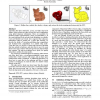Free Online Productivity Tools
i2Speak
i2Symbol
i2OCR
iTex2Img
iWeb2Print
iWeb2Shot
i2Type
iPdf2Split
iPdf2Merge
i2Bopomofo
i2Arabic
i2Style
i2Image
i2PDF
iLatex2Rtf
Sci2ools
NPAR
2004
ACM
2004
ACM
Hardware-determined feature edges
Algorithms that detect silhouettes, creases, and other edge based features often perform per-edge and per-face mesh computations using global adjacency information. These are unsuitable for hardware-pipeline implementation, where programmability is at the vertex and pixel level and only local information is available. Card and Mitchell and Gooch have suggested that adjacency information could be packed into a vertex data structure; we describe the details of converting global/per-edge computations into local/per-vertex computations on a related ‘edge mesh.’ Using this trick, we describe a feature-edge detection algorithm that runs entirely in hardware, and show how to use it to create thick screen-space contours with end-caps that join adjacent thick line segments. The end-cap technique favors speed over quality and produces artifacts for some meshes. We present two parameterizations for mapping stroke textures onto these thick lines—a tessellation-independent screen space metho...
| Added | 30 Jun 2010 |
| Updated | 30 Jun 2010 |
| Type | Conference |
| Year | 2004 |
| Where | NPAR |
| Authors | Morgan McGuire, John F. Hughes |
Comments (0)

